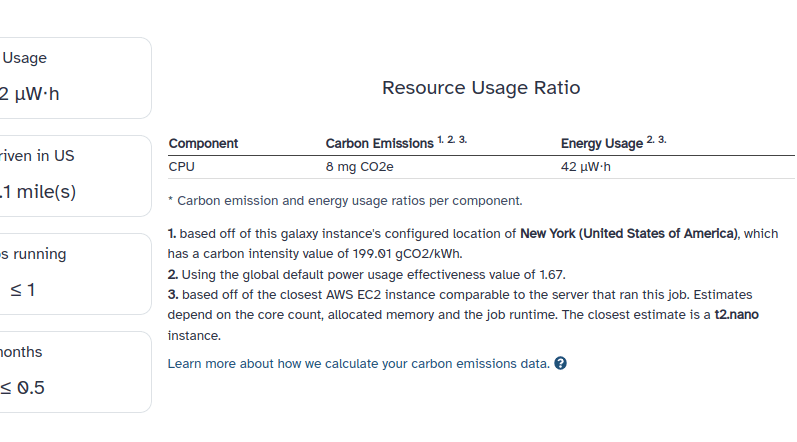Carbon Emissions Reporting in Galaxy
Dynamic carbon emissions reporting for jobs in Galaxy
Hello, I'm Rendani, a front-end developer and computer science student working in the Galaxy Freiburg team. For my bachelor project, I had the pleasure of implementing the carbon emissions reporting feature for jobs in Galaxy.
Why calculate carbon emissions in the first place?
As we know, cloud computing doesn't come for free. While storing a few files on your local computer may not have a significant carbon footprint, running large bioinformatic workflows can have a substantial impact. During my research for this project, I was surprised to learn about the various factors that effect carbon emissions, such as the power usage of the data center housing your server and the carbon intensity of the country its running in. Algorithm runtime, hardware specifications and geographical location all have an impact on how "green" your computations are.
What's new
Carbon emissions reporting in Galaxy is based off of the work done by the Green Algorithms Project and in particular their implementation of the "carbon footprint calculator". Our implementation has been slightly adjusted to better fit our use case. Additionally, some of our carbon emissions reporting is based off of calculations done by the United States Environmental Protection Agency (EPA).
Currently, whenever you run a job in Galaxy and navigate to the dataset details section of that job, you're presented with a carbon emissions summary detailing the estimated CO2 output and energy usage of that job. Additionally, we compare your job's carbon footprint to things like the distance driven in a car or the amount of smartphones you could have charged given your job's energy usage. This helps make the numbers more relatable. Here's an example carbon emissions report:

Implementation details
In order to estimate a job's carbon footprint, we first compute its energy usage in watts. We consider metrics like the job runtime (in hours), its memory usage (in MiB) and hardware specific information about the server running your job. In particular, make use of information like the number of compute cores allocated to the job, the total available cores and the TDP (Thermal Design Power) of the server's CPU. We also assume that 100% of each core allocated is used.
Since hardware specifications vary greatly and that we can't always assume that this information is provided, we estimate the server's hardware configuration by matching your job's CPU and/or memory usage to a comparable general purpose AWS EC2 instance. EC2 offers a wide range of server configurations allowing us to cover more real-world situations.
Once we have the information needed, we calculate the power usage of the CPU and memory in watts. For each component, the respective power usage is the product of the amount of allocated resources, a power usage effectiveness value and a power usage factor. For CPUs, the power usage factor is the CPU TDP per core and, for memory, we use a reference average power draw constant of 0.375 W/GiB from the "Carbon Footprint Calculator". Here's what that calculation looks like:
memory_allocated_in_gibibyte = memory_allocated_in_mebibyte / 1024
tdp_per_core = cpu_TDP / cpu_core_count
normalized_tdp_per_core = tdp_per_core * cores_allocated_to_job
power_needed_cpu = pue * normalized_tdp_per_core
power_needed_memory = pue * memory_allocated_in_gibibyte * memory_power_usage_constant
total_power_needed = power_needed_cpu + power_needed_memory
The power usage is then converted into energy usage (in kWh) by factoring in the job runtime (in hours):
energy_needed_cpu = runtime * power_needed_cpu / 1000
energy_needed_memory = runtime * power_needed_memory / 1000
total_energy_needed = runtime * total_power_needed / 1000
Finally, we convert the energy usage into estimated carbon emissions (in metric units CO2e) by multiplying the carbon intensity of the server location. CO2e represents other green house gases that have the same global warming effect as a metric unit of carbon dioxide, while carbon intensity is a measure of how environmentally friendly the energy production is in a particular country. The carbon intensity is dependent on geographical location, so Galaxy allows admins to specify the geographical location of the server running the Galaxy instance. In the current implementation, we assume that all jobs are run in the same geographical location as the configured location.
cpu_carbon_emissions = energy_needed_cpu * carbon_intensity
memory_carbon_emissions = energy_needed_memory * carbon_intensity
total_carbon_emissions = total_energy_needed * carbon_intensity
We compare your job's total carbon emissions with values calculated by the EPA. When calculating the equivalent distance driven, we use the reference values from the Green Algorithms Project's "Carbon Footprint Calculator".
gasoline_consumed = total_carbon_emissions / gasoline_emissions_as_per_epa
carbon_carbon_savings_by_using_leds = total_carbon_emissions / led_carbon_savings_as_per_epa
equivalent_km_in_eu = total_carbon_emissions / average_passenger_car_emissions_eu
equivalent_km_in_us = total_carbon_emissions / average_passenger_car_emissions_us
smartphones_charged = total_carbon_emissions / smartphone_charged_emissions_as_per_epa
tree_months = total_carbon_emissions / tree_year * 12
Configuration options
The Galaxy configuration interface has been extended to allow admins customize the carbon emissions reporting behavior and improve estimation accuracy The following flags were added:
geographical_server_location_codean ISO 3166 code specifying the geographical location of the Galaxy instance.power_usage_effectivenessthe PUE value to use in carbon emissions calculations.carbon_emission_estimatesa feature toggle flag allowing the to be completely disabled when needed.
As mentioned, we assume that jobs are run in the same geographical location as the configured Galaxy server location. An example of a galaxy instance configured with a location looks as follows:

Next steps
It would be interesting to consider computations using GPU cores, for jobs that use them, or to look into estimating data storage and transfer emissions for file upload jobs. Another useful feature would be calculating the total carbon emissions of an entire history or specific workflow.
References
- Lannelongue, L., Grealey, J., Inouye, M., Green Algorithms: Quantifying the Carbon Footprint of Computation. Adv. Sci. 2021, 8, 2100707. https://doi.org/10.1002/advs.202100707
- "Greenhouse Gases Equivalencies Calculator - Calculations And References | US EPA". 2015. US EPA. https://www.epa.gov/energy/greenhouse-gases-equivalencies-calculator-calculations-and-references.